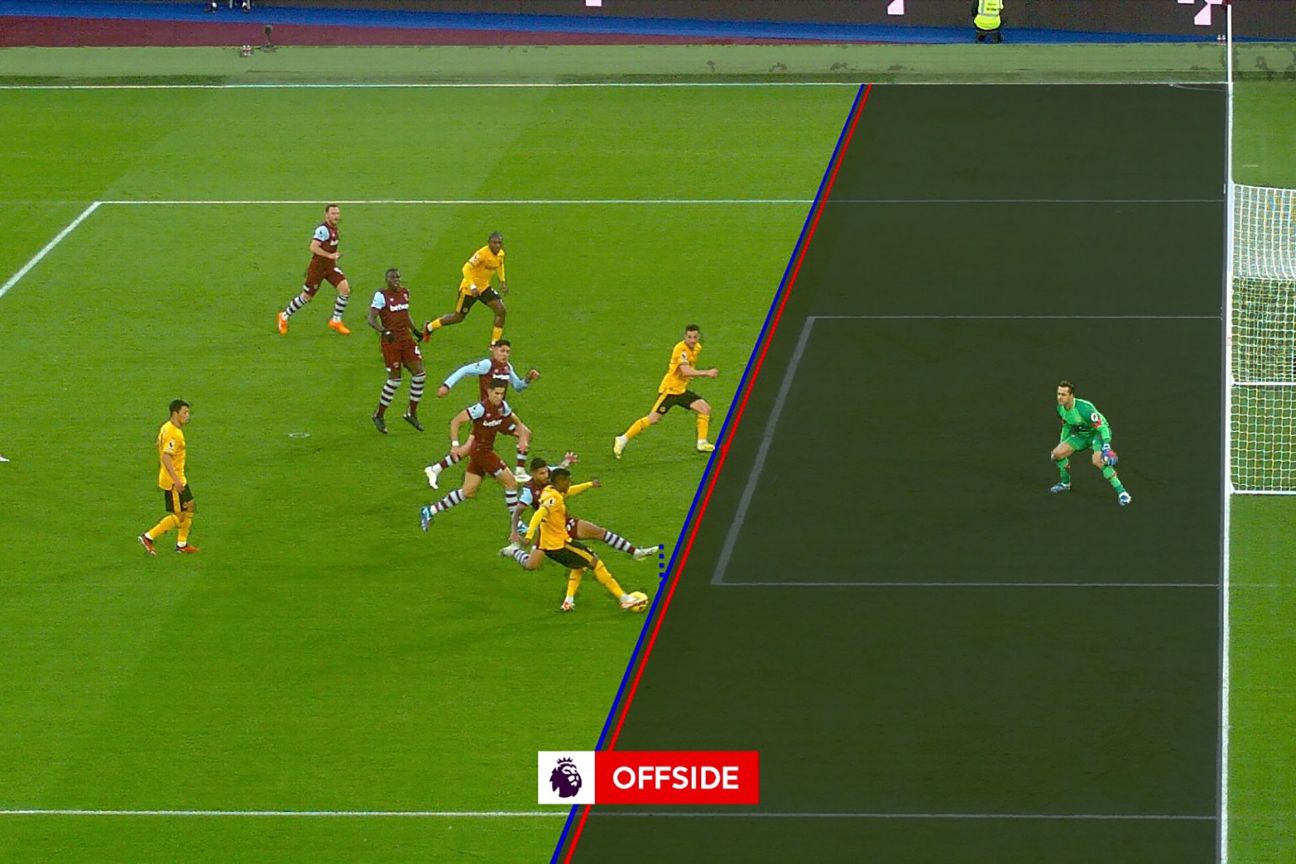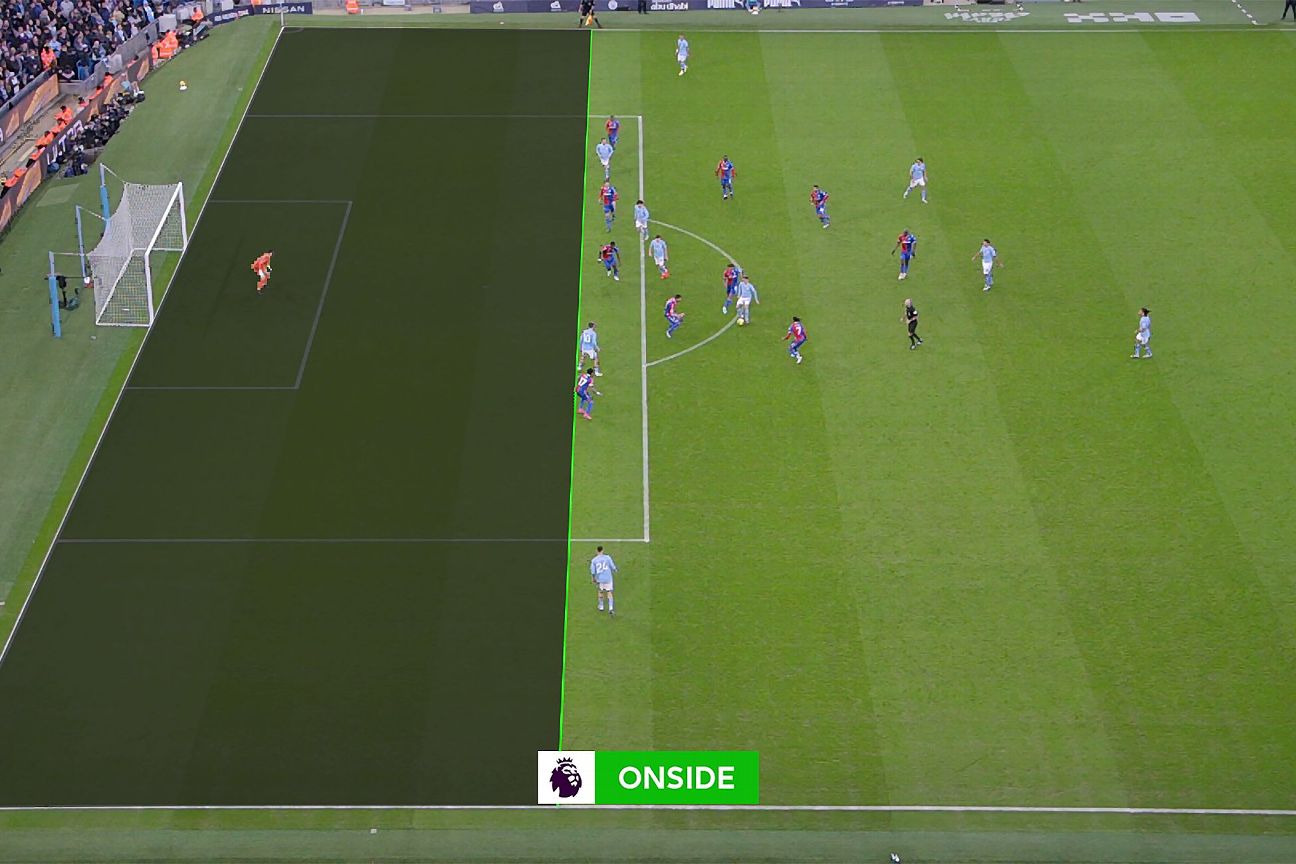
Dale Johnson, General Editor, ESPN FCDec 18, 2023, 12:50 PM
Video Assistant Referee causes controversy every week in the Premier League, but how are decisions made, and are they correct?
After each weekend we take a look at the major incidents, to examine and explain the process both in terms of VAR protocol and the Laws of the Game.
- How VAR decisions have affected every Prem club in 2023-24
- VAR in the Premier League: Ultimate guide
In this week's VAR Review: Why Manchester United defender Luke Shaw didn't concede a handball penalty against Liverpool, and Manchester City goalkeeper Éderson wasn't sent off. Plus, how West Ham United defender Vladimír Coufal avoided a red card.
Liverpool 0-0 Man United
Possible penalty: Handball by Shaw
What happened: The ball was played into the box by Kostas Tsimikas in the 84th minute, bouncing up and hitting Shaw's arm. Liverpool's players wanted a penalty from referee Michael Oliver, who ignored the appeals, and the VAR came into action.
VAR decision: No penalty.
VAR review: The ball came off Shaw's leg, bounced and went up onto his arm, which was in an expected position for his movement. Even without the touch off the leg, we should not expect a penalty to be awarded for this in the Premier League with its more lenient application of the handball law.
While there's no automatic exemption for a deflection off the body, the arm would have to be fully extended away from it for the defending player to be judged to be committing a handball offence -- as with the handball penalty by João Gomes for Wolves against Luton Town earlier this season.
We saw a penalty incorrectly given through VAR to Paris Saint-Germain against Newcastle United in the Champions League last month after the ball deflected off Lewis Miley and onto his arm, which was also in an expected position for his movement and not out creating a barrier. UEFA removed the video assistant referee in that game from their next appointment.
We've seen a number of similar situations in the Premier League this season not penalised, including Virgil van Dijk against Brighton & Hove Albion when the ball came off his thigh and onto his arm.
Possible penalty: Amrabat challenge on Diaz
What happened: Liverpool were on the attack in the 77th minute when Luis Díaz got a shot off, and then collided with Sofyan Amrabat. There were no real appeals for a penalty from Liverpool's players, but it was checked by the VAR, John Brooks (watch here.)
VAR decision: No penalty.
VAR review: While Amrabat did bring Diaz down, this was only a consequence of trying to block a shot on goal.
Penalties are usually only awarded in cases like this when a defending player has made a reckless challenge, rather than it being a result of a striker being closed down, or an attempted block being made.
Manchester City 2-2 Crystal Palace
Possible red card: DOGSO by Éderson
What happened: Éderson came racing out of his area in the 42nd minute and brought down Jean-Philippe Mateta, who was running onto a through-ball from Michael Olise. Referee Paul Tierney showed a yellow card for stopping a promising attack, but was there a case for it to be upgraded to red for denying an obvious goal-scoring opportunity (DOGSO)?
VAR decision: No red card.
VAR review: This is a borderline call, and there's an argument for a red card. Yet there's enough doubt over a couple of clauses in the law for a caution to be considered an acceptable outcome.
The touch by Mateta takes the ball in the general direction of the corner flag rather than the goal, while Rúben Dias was in close proximity to make a possible challenge. Ederson was out of his goal, but this alone doesn't create a DOGSO situation.
Without being brought down by Éderson there's the possibility Mateta could hit it first time and score from a tight angle. Had the referee produced the red card it wouldn't have been overturned. But the difficulty of the goal-scoring opportunity, coupled with the threshold for a VAR intervention, means the card wouldn't be upgraded.
Compare it to the red card given by the referee on the field for Van Dijk against Newcastle United. Alexander Isak was in a central position and had a direct run to goal for a goal-scoring opportunity; Mateta was out wide on the edge of the penalty area with the ball moving away from goal rather than towards it.
Possible offside: Lewis when scoring
What happened: Rico Lewis doubled Manchester City's lead in the 54th minute, but there was a check for a possible offside.
VAR decision: Goal stands.
VAR review: It was initially difficult to make out who touched the ball at the relevant points for an offside decision, but it soon became clear there was no possible offence.
When the ball is played by Jack Grealish, goal-scorer Lewis and Rodri, who challenged, are both onside. Even if Rodri had touched the ball, Lewis was still onside at this point.
It's then Crystal Palace midfielder Jeff Schlupp sticks out a leg and plays it to Lewis.
As no other City player touches the ball before it gets to Lewis, the offside phase is set at Grealish's touch -- there can be no offside.
Possible penalty overturn: Foden foul on Mateta
What happened: Palace were handed the chance to equalise in the third minute of added time when Mateta went down under a challenge from Phil Foden, and referee Tierney pointed to the spot.
VAR decision: Penalty, scored by Olise.
VAR review: One of the clearest penalties you're likely to see, with Foden catching the Palace striker high on the shin after missing the ball.
Foden wasn't leading with studs in catching Mateta with his follow-through, so there's no case for a red card. But the Manchester City player was fortunate to escape a caution.
West Ham 3-0 Wolves
Possible red card: Coufal challenge on Bellegarde
What happened: Vladimír Coufal challenged Jean-Ricner Bellegarde in the 44th minute and caught the Wolverhampton Wanderers player in the face. Referee Chris Kavanagh gave no sanction to the West Ham United defender, while the VAR, Jarred Gillett, checked for a possible red card for violent conduct.
VAR decision: No red card.
VAR review: It's the only decision from this weekend that the Premier League's Independent Key Match Incidents Panel may possibly log as an error.
Coufal runs into the Wolves player and catches him in the face with force. The only thing that could have saved the Czechia international from a red card is he didn't throw his arm or elbow, and it could be argued that Coufal goes to put his arm across his opponent and the connection with the face was inadvertent. But with the force involved it's easy to see why so many feel this should be a dismissal.
Gillett, the VAR who the panel said missed a red card for serious foul play by Luton Town's Jacob Brown against Manchester City last weekend, decided this wasn't a violent act.
Somehow the West Ham United player escaped without a booking for the challenge, not something the VAR is able to intervene on.
There have been several incidents of a player catching an opponent in the head in the Premier League this season, yet only two have been logged as VAR errors: João Palhinha on Pascal Groß in Brighton vs. Fulham and Bruno Guimaraes on Jorginho in Newcastle United vs. Arsenal. All other situations have been supported by the panel as correct on the pitch and in the VAR hub, including Diego Carlos on Eddie Nketiah in Aston Villa vs. Arsenal last weekend, plus two examples involving Fulham's Carlos Vinícius.
Possible offside: Sarabia when scoring
What happened: Pablo Sarabia thought he had given Wolves a way back into the game in the 58th minute, but there was a VAR check for a possible offside.
VAR decision: Goal disallowed.
VAR review: The technology told the video assistant referee that the foot of West Ham defender Emerson was marginally ahead of the ball, making him the offside line. There was a clear gap between the attacking and defensive lines, meaning the goal had to be disallowed.
This check took over three minutes, which has become standard practice since the error to wrongly disallow Luis Díaz's goal for Liverpool at Tottenham Hotspur.
These long waits will hopefully be a thing of the past, for the most part, once semi-automated offside technology is introduced next season.

"We're looking at that behind the scenes," chief refereeing officer Howard Webb revealed last week. "We're testing various technologies around semi-automated offside to see how they could positively impact the Premier League. We'll continue doing that in the coming weeks and months and then a decision will be taken, I would anticipate, towards the end of the season."
Premier League clubs voted against introducing semi-automated offside technology for this season, but it's hard to see how they can resist it again to remove the long waits and concerns over human error.
In the current technology, the defensive and attacking lines have to be touching for a player to be onside within the tolerance level, or margin of error. When that happens a single green line to the defender is displayed, as was the case with the onside decision for Grealish's goal against Palace.

Nottingham Forest 0-2 Tottenham
Possible red card: Bissouma foul on Yates
What happened: In the 69th minute, Tottenham Hotspur's Yves Bissouma turned on the ball but his touch was slightly heavy. Nottingham Forest's Ryan Yates closed him down and got to the ball first, before he was caught by Bissouma. Referee Jarred Gillett played advantage on a Forest attack and came back to book Bissouma at the end of the move. The VAR, Michael Oliver, checked for a possible red card for serious foul play.
VAR decision: Red card.
VAR review: Gillett's view of the incident appeared to be obscured, so he might not have seen the nature of the contact from Bissouma.
The contact on Yates, with studs leading, is so high it almost catches him on the knee.
There's always questions about consistency and the application of serious foul play in the Premier League, especially as there are so many fewer direct red cards in English football compared to the other top European leagues and the Champions League.
Last week, the Premier League's independent panel logged two missed red cards, the challenge previously mentioned by Brown against Man City, plus Brentford's Frank Onyeka on Vinicius Souza of Fulham. Of the 15 missed VAR interventions this season, six of them have been red cards: three for serious foul play, two for violent conduct, plus the red card for Liverpool's Alexis Mac Allister against AFC Bournemouth which should have been rescinded.
It shows there's still work to be done to get serious foul play and red cards in general right with VAR. Perhaps last week's missed reds influenced some VAR decisions this weekend -- though they are the first VAR failures since Nov. 4.
There was a change of protocol this weekend, with the Premier League reacting to concerns that a referee was being influenced by being shown a freeze-frame of contact when going to the monitor to review a possible red card, which is in line with UEFA and the other top leagues. For instance, Liverpool were furious that referee Simon Hooper was presented with an image of the contact made by Curtis Jones when he was sent off at Tottenham.
In the Bissouma review, and the two other red-card overturns this season, the referee was first shown the incident at full speed.
Newcastle 3-0 Fulham
Possible red card: Jimenez challenge on Longstaff
What happened: Sean Longstaff went to control a ball in the 20th minute and Raúl Jiménez jumped into him. Referee Sam Barrott showed a yellow card, but there was a VAR check by Michael Salisbury for a possible red card.
VAR decision: Red card.
VAR review: Jimenez was worked up from a challenge moments earlier when he was caught in the face by Jamaal Lascelles, though there was never any prospect of a red card being produced on that situation with the Newcastle defender not throwing his arm.
The Fulham striker jumps into the challenge with the ball at shin height yet leads with a foot above the ball. Even though Jimenez pulls his leg out of the challenge, he's gone in with such force, completely out of control, and he connects with Longstaff's head with his hip.
It was a clear case of endangering the safety of an opponent.
Brentford 1-2 Aston Villa
Possible penalty: McGinn challenge on Mee
What happened: Brentford wanted a penalty in the 11th minute when Ben Mee went down under pressure from John McGinn. Referee David Coote waved play on while the VAR, Craig Pawson, checked for a possible penalty.
VAR decision: No penalty.
VAR review: After the match Brentford manager Thomas Frank was adamant this should be a penalty, saying that it ticked all the boxes as set out in Premier League guidance.
There's a case for it, but it's questionable if it meets all the criteria. That said, the perception is that penalties for holding have become inconsistent this season.
Guidance says that "sustained holding that prevents an opponent from having the opportunity to play or challenge for the ball" should be penalised.
Within this the considerations are:
Players who only focus on an opponent and pay no attention to challenging for the ball and have a material impact
Players who clearly hold an opponent by pulling their shirt and clearly prevent movement and the ability to play or challenge for the ball
Where both players are involved in simultaneous and similar actions, play should be allowed to continue
The referee has decided that both players are holding each other. While McGinn looks at Mee at first, he is fully focused on the ball as it comes over and not only the opponent; this won't be seen as an incorrect decision.
Possible red card: Mee challenge on Bailey
What happened: Brentford were on the attack in the 71st minute when the ball dropped outside the area from a corner routine. Mee jumped into a challenge on Leon Bailey, and referee Coote showed a yellow card. The VAR checked for a possible red.
VAR decision: Red card.
VAR review: There were two situations in the game with VAR checks for a red card against Brentford players. The first, from a tackle made by Christian Nørgaard, had limited contact low on the boot with little force after the midfielder had kicked the ball.
Mee's challenge has direct comparisons with Bissouma's red card, and also Kai Havertz's challenge vs. Newcastle, which the independent panel said was a missed VAR dismissal. While there was only a small amount of contact by Mee on Bailey, it's the nature of the challenge which earns the red card.
Mee leaves the ground with both feet and then jumps into the challenge. While Coote is very close to the incident, that can actually make judgements more difficult for a referee. It's likely Coote didn't see the full nature of the challenge from close proximity.
Possible penalty: Konsa challenge on Maupay
What happened: Neal Maupay broke into the box in the 72nd minute and went down under a challenge from Ezri Konsa. Referee Coote waved away the penalty claims, giving handball against the Brentford striker after he went to ground.
VAR decision: No penalty.
VAR review: Maupay slowed his run and made a clear movement to his right to initiate the contact with the defender, rather that continuing on his running line or moving the ball across his opponent. The VAR won't get involved in a penalty in this situation.
Possible red card overturn: Kamara on Yarmoliuk
What happened: Boubacar Kamara was sent off in the seventh minute of added time after an altercation on the touchline. The VAR checked the red card was correct.
VAR decision: Red card stands.
VAR review: Kamara pushed Yehor Yarmoliuk in the face in front of referee Coote; a clear act of violent conduct and a red card was the only possible outcome.
There was also some pushing and shoving after Ollie Watkins scored the winning goal, but this was more a case of players grabbing each other with no push to a face.
Some parts of this article include information provided by the Premier League and PGMOL.
 (1).png)
 1 year ago
22
1 year ago
22


















